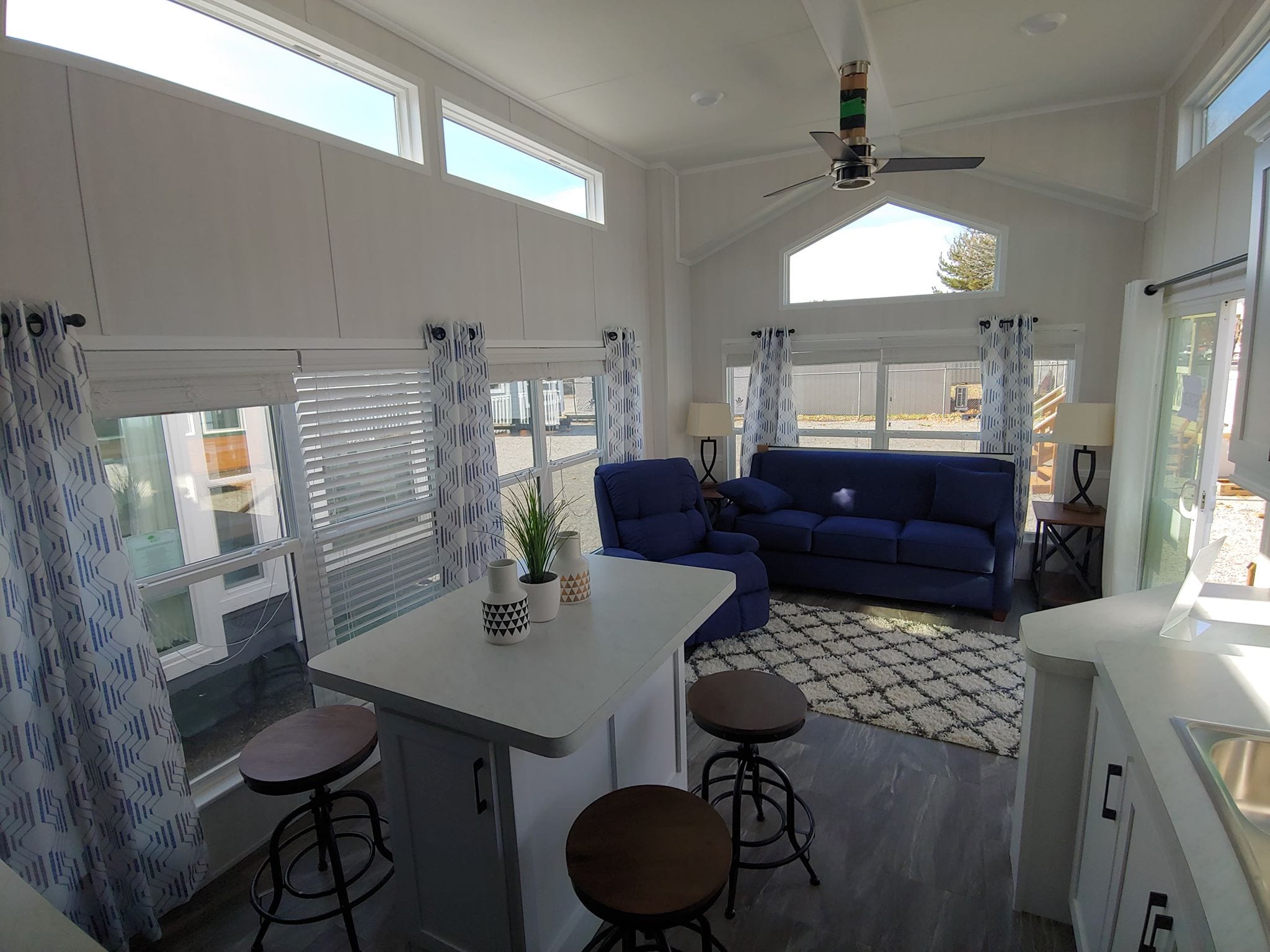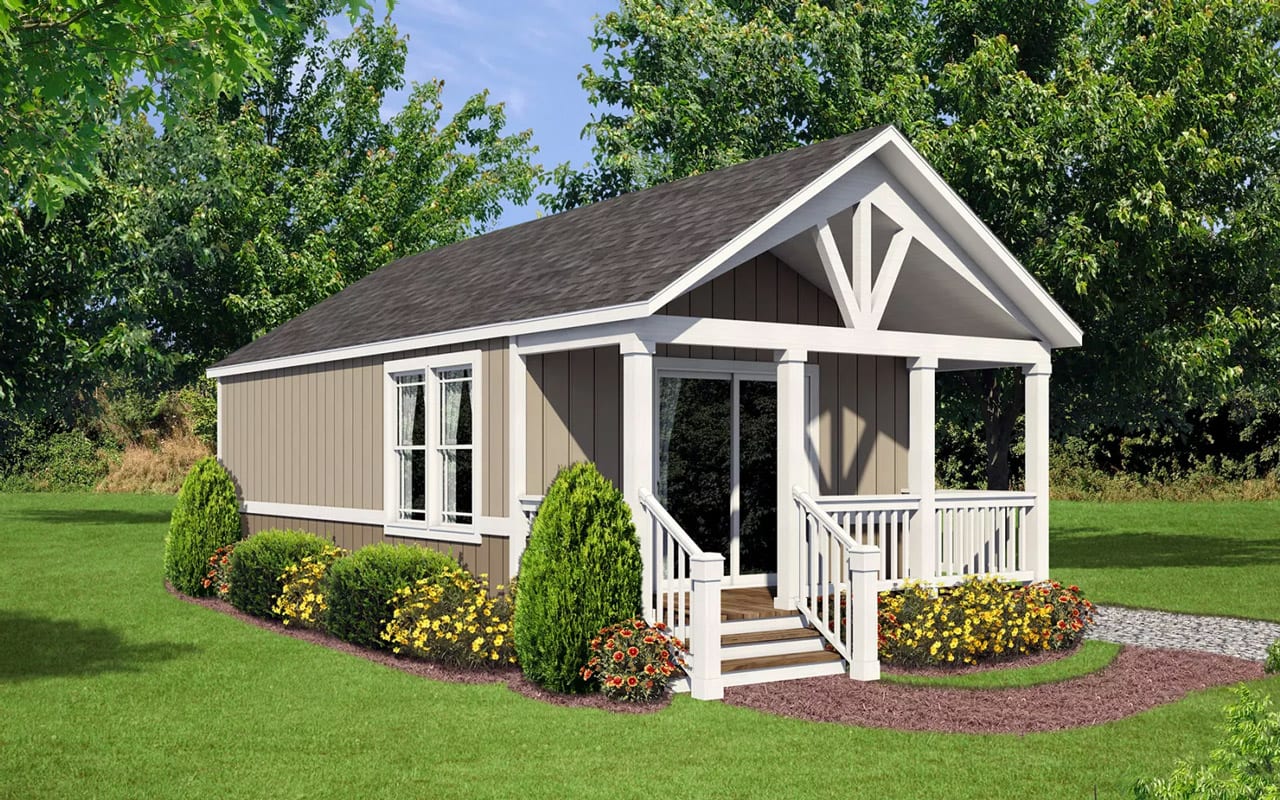Many people moving into a park model house or tiny home wonder whether their smaller square footage will be enough for their furry companions.
Actually, living with one or more dogs or cats in a tiny house is easier than you think, though it does require you to make some adaptations. Below are some quick tips to help you transition into sharing your tiny home with pets.
1. Give each pet a private spot.
Both dogs and cats like to have a private place they can retreat to when they need it. It can be difficult to find a way to offer this in a tiny house, but not impossible. Even just a quiet spot under or behind a furnishing is sometimes enough.
2. Go with hardwood floors.

While tiny houses give you less flooring to keep clean, in a way, it is like you are living in your own entryway. Dirt, dust, pet hair and litter tend to accumulate rapidly. For that reason, you may want to avoid carpeted floors and opt for hardwood or tile like you see here in the Woodland Park Front Kitchen model. Floors like these can be swept clean in minutes.
3. Put perches by windows.

Both dogs and cats love to watch the outside world through large windows like those in the Grand Tetons park model home.
Cats like perching in high places, so think about installing a perch or even a catwalk just under one of the high windows in your tiny house.
4. Get collapsible supplies.
When living in a tiny house, you need to always be thinking about how you can maximize your available space. One trick to doing that when you have pets is to invest in supplies that you can collapse when they are not in use. So, instead of large, hard crates, for example, you could get collapsible crates. There are also collapsible cat tunnels on the market.
5. Avoid cat litter messes.
As we mentioned, the floor of a tiny house can accumulate debris fast—and nothing spreads faster than clay cat litter. Consider switching to pine pellet litter if your cats will allow it.
6. Get used to barricading.
There are going to be times when you need to section off parts of your home with gates to keep your cats or dogs from going where they shouldn’t. You may even need to block the doors when you go in and out if you have cats. You will get used to this faster than you think, however.
7. Enjoy your outdoor living spaces with your pets.

Tiny homes are very much built to keep you connected with the outdoors. That is great news for cats and dogs, who love the fresh air and all the interesting sights, smells and sounds outside.
A home with a large porch gives you a great place to relax with your dog. If you have a cat, consider investing in a “catio” so your feline can enjoy the outdoors without wandering off.
8. Handle introductions with extra care.
At some point in the future, you may end up adding another pet to a household that already has one or more cats or dogs.
You likely already know that gradually introducing pets to each other can be critical for their relationships. That becomes challenging in a tiny house, as many of the standard techniques (i.e. keep the new animal in a separate room initially) are sometimes not applicable.
Nonetheless, there may still be ways you can take introductions slowly. For example, if you are adopting a stray cat from outside, you can feed it outside for a while before you start bringing it in.
9. Play extra with pets.
It can be difficult for cats and dogs to get their exercise indoors in a small space. So, you may need to be more proactive living in a tiny house with your pets, spending extra time playing with them through the course of the day. That way, they will stay physically and mentally healthy, and will be less likely to keep you up at night bounding around your home.
10. Be patient and adapt.
Perhaps the single most important thing to know about living in a tiny house with pets is that it can be a little trying at first.
You may be used to a bigger space, and no doubt, your pets are as well. So, there will be an adjustment phase for all of you.
That means you need to be willing to be patient. There are going to be days the floor is extra dirty, or nights you are kept awake as your cats run back and forth. There may be issues between your pets as they negotiate the smaller space and each look for their own secluded zones. You might sometimes need to work hard to come up with clever solutions.
But within a few weeks or months, everything should settle down, and you and your pets will find new routines. Before long, living in a tiny house with your cats or dogs will feel little different to living in a full-size, traditional home with pets.
Plus, there is one major benefit of sharing a tiny house with your pets, and that is that you get to be around them all the time! Even if you have a cat that tends to be fairly quiet and solitary, they will always be close by.
If you are ready to move into a park model home with your beloved pets, please contact us. We can recommend pet-friendly layouts and offer you additional tips for sharing your tiny home with your cats or dogs.

